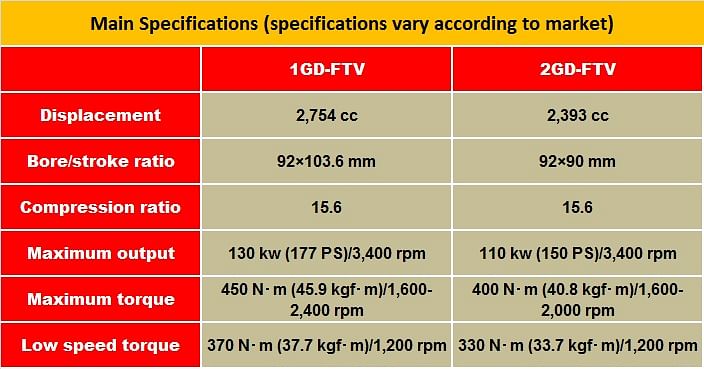Toyota’s revamped turbo-diesel engines feature advanced thermal insulation diesel combustion
Toyota says its newly developed direct-injection turbo diesel engines raise the bar for fuel efficiency, power and quietness.
Toyota says its newly developed direct-injection turbo diesel engines raise the bar for fuel efficiency, power and quietness.
The world's first use of Thermo Swing Wall Insulation Technology (TSWIN) makes the 2.8-litre 1GD-FTV engine one of the most thermally efficient in existence, with a maximum thermal efficiency of 44 percent. Despite smaller engine displacement in comparison to the current KD engine, maximum torque is improved by 25 percent and low speed torque improved by 11 percent, while fuel efficiency has received a 15 percent boost.
The new GD Series consists of two diesel engines – a 2.4-litre turbo-diesel, expected to replace the current 2.5-litre diesel unit, and a 2.8-litre that will replace the current 3.0-litre unit. The new 2.4-litre 2GD-FTV motor is rated at 148bhp and 40.78kgm of torque while the larger 2.8-litre 1GD-FTV is rated at 175bhp and 45.9kgm of torque.
With the use of Thermo Swing Wall Insulation Technology and the use of silica-reinforced porous anodized aluminium (SiRPA) on the pistons, cooling loss during combustion is reduced by approximately 30 percent. SiRPA is a high insulation and dissipation material that is easy to heat and easy to cool.

A port shape more conducive to air intake drastically increases the amount of air flow into the cylinders. Additionally, a newly developed piston combustion chamber shape and a common-rail fuel injection system that achieves higher pressure and more advanced control of fuel injection pressure are used to optimise the injection of fuel into the combustion chamber. This maximises air consumption, enabling high thermal efficiency and low emissions.
Precise pilot injection matching the state of the ambient air occurs before the main injection to shorten ignition delay, achieving stable combustion even in the world's harshest environments, while ensuring quiet operation and high thermal efficiency.
Also, the new turbocharger used by the GD engines is 30 percent smaller than its current equivalent, and features a newly developed turbine that improves efficiency, and a newly developed impeller that provides instantaneous acceleration response and produces maximum torque over a wide range of rpm.
The engines also have Toyota's first-ever urea Selective Catalytic Reduction (SCR)6 system that can eliminate up to 99 percent of emissions of NOx (nitrogen oxide), one of the main causes of air pollution.
The newly developed 1GD-FTV is currently available in the new Hilux small pickup truck launched in Thailand in May 2015, and in the partially redesigned Land Cruiser Prado launched in Japan on June 17. The same engine line-up includes the 2GD-FTV 2.4-litre direct-injection turbo-diesel engine.
From the Indian market perspective, the Toyota GD-Series will replace the current KD-series engines which power the Innova MPV and the Fortuner SUV.
RELATED ARTICLES
Horse Powertrain reveals hybrid conversion for electric cars
Engine-making joint venture of Geely and the Renault Group announces new hybrid powertrain that fits into the same space...
Aisin to produce hybrid motor for Mitsubishi in Thailand
The hybrid drive motor and gearbox, will be produced at Aisin Powertrain (Thailand) Co for use in the Mitsubishi XForce ...
GM reports strong Q1 sales in China, demand for EVs and hybrids surges 53%
General Motors and its joint ventures in China have sold more than 442,000 units between January and March 2025.






 By Autocar Professional Bureau
By Autocar Professional Bureau
 22 Jun 2015
22 Jun 2015
 13446 Views
13446 Views
















